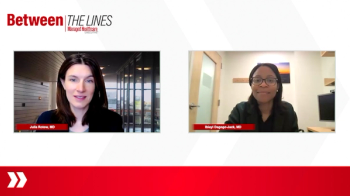
Adverse Event Profile of Bempedoic Acid
Drs Cho and Martin examine the side effect profile associated with bempedoic acid.
Episodes in this series
Leslie Cho, M.D., FACC, FESC, FSCAI: Maybe we can move on to the side effects of the drug, which I think is something we should talk about. There’s been lots of discussion about the [side] effects. So Seth, maybe you can talk us through the side effect of the drug.
Seth S. Martin, M.D., M.H.S., FACC, FAHA, FASPC: First of all, if we look at serious [side effects], it’s the same between the bempedoic acid [Nexletol] group at 25%. And it’s 25% in the placebo group. There’s no difference there. I would draw our attention to gout, where it was 3.1% versus 2.1%. And of course, this had been seen in prior work, on bempedoic acid there was more hyperuricemia at 10.9% versus 5.6%. So this is something to consider in your patients who have a history of gout. There was a small increase in cholelithiasis 2.2% versus 1.2%. So these are small numbers. But those are the 2 that I would draw attention to. Interestingly, in prior studies, there had been some concern around tendon pathology, which was not detected in CLEAR Outcomes [trial, NCT02993406].
Leslie Cho, M.D., FACC, FESC, FSCAI: That’s right. The tendon rupture or the tendinitis was not seen. The other very interesting thing is looking at the milder rates between bempedoic acid and placebo, lower than placebo, which is very good, and also the new onset of diabetes is lower or similar between the two groups. So this drug doesn’t cause or doesn’t bring on diabetes earlier as statins do. I think we should probably finish our discussion today by talking about where this drug fits in. I’m super excited to hear your thoughts on where this drug fits in our current armamentarium of lipid management.
Seth S. Martin, M.D., M.H.S., FACC, FAHA, FASPC: Yeah. This is the key question. I think you and I both started alluding to this in some ways. Part of it is around the increasing use of combination therapy because there is a fixed-dose combination pill with bempedoic acid and ezetimibe [Zetia]. I do think that is a real opportunity we’re talking about the two together, about a 40% LDL [low-density lipoprotein] cholesterol reduction. So that’s a legitimate contender to other options, such as PCSK9 inhibitors, which can lower LDL by 45% to 60% or so. And you mentioned that in the real world, we see patients who have a strong preference for oral therapy over injectable therapy. So I think that’s part of the equation we use, as we explore options with our patients and really factor in their preferences as well as where we need to go. I do think that it certainly, it’s obvious that we would target our patients that have statin intolerance. But even though some patients, such as the 20% or so patients that are still able to take statins, I see a real opportunity to then add on bempedoic acid plus ezetimibe on top of statin therapy.
The cost issues still will play out. This is a medicine that can require prior authorization and could cost hundreds of dollars per month for a patient, so depending on what a patient’s paying out-of-pocket and how much friction there is in a prior authorization process, I think that’s going to make a real impact in dictating which patients use this therapy in the real world in which clinicians have the time and wherewithal to actually be prescribing it and managing it. And it may be that additional analyses will help continue to inform the cost side of things. But overall, as we said at the start, we need more tools for lipid management so this is a great tool. I would of course use it in the way that it was used in the trial. And I would really encourage clinicians, even if you’re not signing a formal consent paper to really bring the spirit of that to the clinic, to have that frank conversation and make sure that patients are making very informed decisions. So I think that that’s really important and an innovation that was provided by the CLEAR Outcomes trial. But I think that, although I will use it in the way that it was used in the trial, I do see an opportunity to use it in other patients that don’t quite meet those criteria. But still, it is another tool for LDL lowering to get down to levels that are recognized as more healthy by our guidelines by the ACC [American College of Cardiology] guidelines and others.
Leslie Cho, M.D., FACC, FESC, FSCAI: I agree. I totally agree. I think you said it very nicely. I think this is a drug that has shown efficacy and safety in patients who are statin-intolerant. Obviously, statins are the cornerstone of therapy, but there are people who can’t take statins or won’t take statins and I think this is a legitimate option. There are people who refuse to take injections, and this is a legitimate option for that population. To initially start with a statin-intolerant patient, or for people who are maximized on statin therapy, they’re still not at goal, diabetics, people who are refusing injection, I think this is a legitimate option that’s available. I think there’s a huge cost that we don’t think about. We think about cholesterol, whatever. But when patients don’t take cholesterol-lowering medicine, and they go on to have events, that’s a real cost, not just to the patient, but also to society. That’s a cost to insurance, to managed care, to everyone. I think we need to think about [that] not taking cholesterol medicine may seem benign, but these studies, again, and again, show us the importance of lowering LDL and trying to get our patients this sort of shared decision-making, so that we can get them to goal is really critically important.
Seth S. Martin, M.D., M.H.S., FACC, FAHA, FASPC: Yeah. Very well said. I totally agree. It’s important for us to recognize that these are the benefits that were seen over a little more than 3 years during the trial. But in the real world, we’re going to use it for much longer periods of time. And as we do reduce that cumulative exposure to LDL, we’re going to see accruing benefits year after year. And so the benefit is going to be expected to be much larger than seen over the shorter period of time in the trial.
Transcript edited for clarity.
Newsletter
Get the latest industry news, event updates, and more from Managed healthcare Executive.
















































